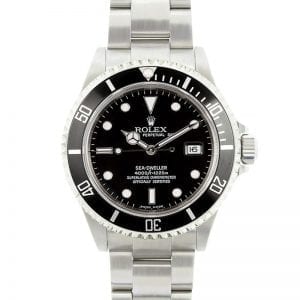Although the Submariner is the most famous Rolex dive watch, there is another collection from the Swiss watchmaking brand that’s heftier, stronger, and more water resistant—the Rolex Sea-Dweller. Born in 1967 as a tool watch for a professional diving company named COMEX, the Sea-Dweller was billed as the ultimate saturation diving watch of the era thanks in part to its helium escape valve.
The Sea-Dweller eventually went beyond COMEX gear to become a part of the main Rolex lineup, where it remains today. Over the last five decades, Rolex has introduced several editions of the Sea-Dweller and today we’ll be comparing three of those models—the ref. 116600, the ref. 116660, and the ref. 116600.
Rolex Sea-Dweller 16600

Introduced in 1988, the Rolex Sea-Dweller ref. 16600 was in production for twenty years. It includes a stainless steel 40mm Oyster case, a black aluminum dive bezel, and a stainless steel Oyster bracelet with a diver’s extension system. Like all preceding Sea-Dweller editions, the ref. 16600 features a date window at 3 o’clock without the Cyclops lens on the sapphire crystal. The lack of the magnification lens is in fact why many people favor the Sea-Dweller.
Since Rolex manufactured the Sea-Dweller ref. 16600 for so long, there are slight differences in the watch depending on the year it was made, particularly the lume on the dial. For instance, from 1988 until 1998, the Sea-Dweller ref. 16600 has tritium on the dial indicated by the “SWISS-T < 25” text. Following that, the Sea-Dweller ref. 16600 includes Luminova on the dial, and then finally SuperLuminova for luminescence.
Waterproof to 4,000 feet, the Rolex Sea-Dweller ref. 16600 was the first Sea-Dweller in the collection to run on the Rolex Cal. 3135 automatic movement. In 2008, Rolex discontinued the Sea-Dweller collection in favor for the Sea-Dweller Deepsea ref. 116660.
Rolex Sea-Dweller Deepsea 116660
 While the Rolex Deepsea ref. 116660 does include the ”Sea-Dweller” label on the dial, it’s a completely different edition of the classic SD models. Introduced in 2008, the Deepsea plunged onto the scene with a hefty 44mm Oyster case that’s 17.7mm thick—making this the biggest Rolex watch to date.
While the Rolex Deepsea ref. 116660 does include the ”Sea-Dweller” label on the dial, it’s a completely different edition of the classic SD models. Introduced in 2008, the Deepsea plunged onto the scene with a hefty 44mm Oyster case that’s 17.7mm thick—making this the biggest Rolex watch to date.
The reason for the size of the case is to ensure the watch’s incredible water resistance of 12,800 feet, which is more than three times that of the previous Sea-Dweller 16600. To achieve this, the case houses a Rolex Ringlock System, the helium escape valve, and a 5mm-thick sapphire crystal.
The first version of the Deepsea 116660 sports the classic back dial and black Cerahcrom ceramic bezel combination. However, in 2014, Rolex released a special commemorative edition with the Deepsea 116660 D-Blue Dial—a dial with a color gradient from blue to black—to honor James Cameron’s historic dive to the Mariana Trench.
Rolex Sea-Dweller 116600
 To the delight of many, Rolex brought back the Sea-Dweller in 2014. The Rolex Sea-Dweller ref. 116600 boasted a host of changes from its predecessor, the 16600, including the Cerachrom ceramic bezel on the 40mm Oyster case. Plus, the diver’s bezel now includes full minute markings rather than just the first 15 minutes. The lume on the dial is what Rolex refers to as Chromalight and it glows blue rather than green in the dark.
To the delight of many, Rolex brought back the Sea-Dweller in 2014. The Rolex Sea-Dweller ref. 116600 boasted a host of changes from its predecessor, the 16600, including the Cerachrom ceramic bezel on the 40mm Oyster case. Plus, the diver’s bezel now includes full minute markings rather than just the first 15 minutes. The lume on the dial is what Rolex refers to as Chromalight and it glows blue rather than green in the dark.
Only in production until 2017, the short-lived Sea-Dweller ref. 116600 was replaced with the new Sea-Dweller 126600.
If you’re looking for a robust professional dive watch, then the Sea-Dweller and the Deepsea have plenty to offer. It’s just a matter of picking which one suits you best.



